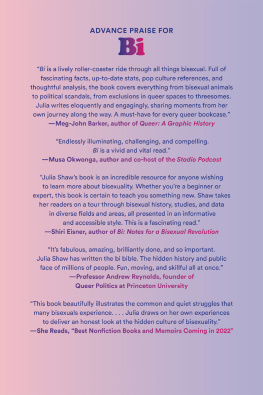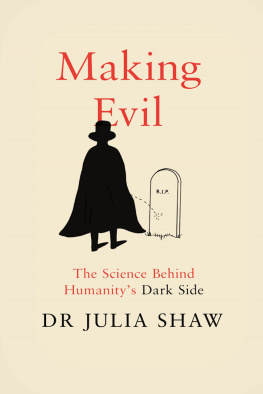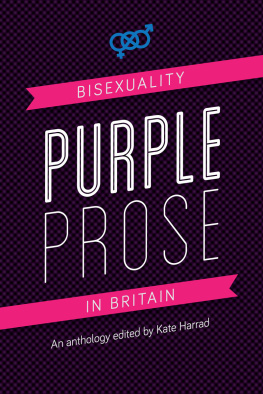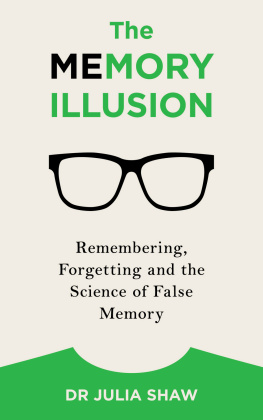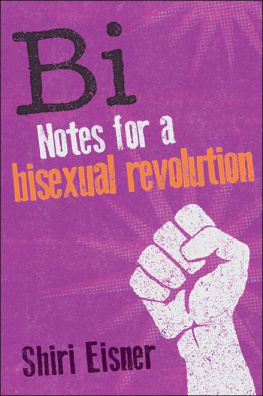Contents
Landmarks
Page List


Copyright 2022 Julia Shaw
Cover 2022 Abrams
Published in 2022 by Abrams Press, an imprint of ABRAMS. All rights reserved. No portion of this book may be reproduced, stored in a retrieval system, or transmitted in any form or by any means, mechanical, electronic, photocopying, recording, or otherwise, without written permission from the publisher.
Library of Congress Control Number: 2021946823
ISBN: 978-1-4197-4435-8
eISBN: 978-1-68335-909-8
Abrams books are available at special discounts when purchased in quantity for premiums and promotions as well as fundraising or educational use. Special editions can also be created to specification. For details, contact specialsales@abramsbooks.com or the address below.
Abrams Press is a registered trademark of Harry N. Abrams, Inc.

ABRAMS The Art of Books
195 Broadway, New York, NY 10007
abramsbooks.com
Sexual
freedom
is
magnificent
and
fragile
CONTENTS

INTRODUCTION
I WANT MORE
I am bisexual, and I have long felt myself wanting more. I have yearned to tether myself to a solid foundation of history and research, to find bi representation in politics and pop culture, and to generally answer the question: Where are all the bisexual people?
When I began my search, I found a crushing void and wondered whether my quest for more was a waste of time. Then I began to familiarize myself with the language of queer scholarship, and slowly the world of bisexual research revealed itself to me. I came to realize that incredible work has been done, but that tragically almost all of it remains concealed from the public. With this book, I want to change that, to bring the colorful world of bisexual scholarship out of the shadows.
I also want people to stop treating bi identities and bi lives as a perversion. To do that we dont just need to better understand bisexuality, we also need to call heterosexuality into question. Bisexuality isnt mysterious, threatening, or performative... or even cool, woke, or transcendental. It is a normal part of human sexuality. Yet, even in the twenty-first century most of us still assume that people are straight until proven otherwise. We center heterosexuality as the sun of our sexual solar system, blinding our exploration of other sexualities. I dont think that everybody is bi, as is so often half-jokingly stated, rather I believe that it is time to queer our worldview by destabilizing our assumptions about sex and sexuality.
There are those who will tell you that this has already happened, that weve awoken from our sexual slumber. As one publisher said to me as their reason for rejecting the proposal for this book, Weve already had that conversation. They meant we as in the whole country. The fire this ignited in me is hard to explain. It wasnt just that this publisher had never actually brought out a book on bisexuality that made me so upset, it was the realization that there are probably lots of people who agree with this statement; people who think that having won some legal rights and protections for bisexual people, or seeing more bi-positive social media posts, or knowing someone who has come out as bi, means that the conversation is over. How can conversations about identity, love, and sex ever be over? Humans obsess over these constructs.
We also need to stop introducing drama into bisexuality where there is none. Commonly misunderstood, and at times willfully misconstrued, is the idea that bisexual people reinforce a strict gender binary. This is neither historically accurate, nor true today. Most bisexual activists and researchers define bisexuality as attraction to people of multiple genders. Notably this definition is inclusive of trans and nonbinary people.
I use the term bisexual throughout this book not because I think this is the term that everyone must use, but because it has the broadest application, longest history, and is the most readily recognizable. In this book I hope to unite the sexual family, no matter what term people feel most suits them, whether its bisexual, plurisexual, pan-sexual, omnisexual, polysexual, fluid, unlabeled, or any related label.
Most of the topics discussed in this book transcend bisexuality and teach us about the core constructs of human sex, love, and relationships. No matter who you are, I hope that this book will enrich and challenge your thoughts on these topics.
As part of my own quest to better understand bisexuality I got in touch with the academic bisexual community in various ways. I started a bisexual research group with regular meetings, spearheaded an international bisexuality research conference which had 485 attendees and 70 researchers presenting their work, and I completed a masters degree in queer history. I already had a PhD in psychology, but to get to where I wanted to be I needed researchers and lecturers to hold my hand and guide me with great patience and care to the information in this book. I now know that there is way more research, history, and scholarly writing on bisexuality than any one book could ever contain. Although necessarily incomplete, I hope that this book does justice to some of the incredible scholars and activists who commit their lives to understanding and protecting bisexual people.
In this book I explore how people have defined and measured bisexuality, uncover its surprisingly long and important history, and learn about some famous bi activists and scholars whom everyone should know. I go on safari, figuratively, to look at behaviorally bisexual animals, and try to understand whether there is a bi gene. I examine why it still feels inappropriate in many places to talk about bisexuality, including at work, and the mental and physical consequences of staying in the big bi closet. I also come to understand the devastating reality of criminalization and human rights abuses that so many bisexual people around the world face, and how we can use our anger to fuel a bisexual revolution. Following this, I try to figure out what a bisexual person looks like (and whether thats even a thing), try to find bi-visibility on-screen, and explore the colorful world of bisexual communities. In the last chapter I jump into perhaps the sexiest topic in the book, threesomes, and look at research into the fun and thorny topic of consensual nonmonogamy.
Whatever your reason for picking up a book that is unapologetically bi, I hope that, like me, you have come here because you want to know more about the history, culture, and science of bisexuality.
THE BI OPTION
There have been suspicions that bisexuality is probably just a trend for almost fifty years. The US magazine Newsweek has even declared this boldly twice. In 1974 it published an article titled Bisexual Chic: Anyone Goes. New again?
These two articles have been widely mocked in bisexual forums. This is particularly true of the 1995 cover, which includes bright white lettering atop a photo of a woman with short hair wearing an oversized black suit and with her arms crossed. She has a guarded expression on her face and is positioned in front of two men in casual gray T-shirts who stare with emotionless expressions into the camera. The photo is so weird, and so over-the-top nineties that it seems almost satirical.

